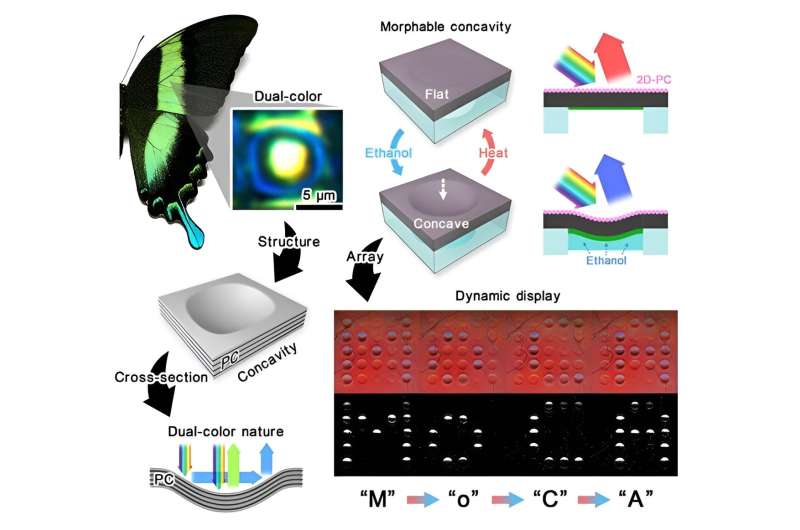This article has been reviewed according to Science X's editorial process and policies. Editors have highlighted the following attributes while ensuring the content's credibility:
fact-checked
peer-reviewed publication
trusted source
proofread
Inspired by butterfly wings, researchers develop a soft, color-changing system for optical devices

Researchers at the University of Hong Kong (HKU) have designed an innovative pixelated, soft, color-changing system called a Morphable Concavity Array (MoCA).
Pixelated, soft, color-changing systems are malleable structures that can change color by manipulating light. They have applications in a wide range of industries, from medical bandages that change color if there is an infection, to foldable screens on smartphones and tablets, as well as wearable technology where sensors are integrated into the clothing fabric.
The research was co-directed by Professor Anderson Ho Cheung Shum from the Department of Mechanical Engineering at HKU, and Professor Mingzhu Li from the Institute of Chemistry, Chinese Academy of Sciences, and led by Dr. Yi Pan from the Department of Mechanical Engineering at HKU.
The study was published in Advanced Science titled "Pixelating Responsive Structural Color via a Bioinspired Morphable Concavity Array (MoCA) Composed of 2D Photonic Crystal Elastomer Actuators."
MoCA fabricated by the HKU researchers is a thin (its thickness is equivalent to about three human hairs) rubber-like structure that consists of two layers—the top layer is a photonic crystal elastomer actuator (PC-EA) film and the bottom one is a hole array—a lattice with regularly spaced round holes.
The PC-EA film itself consists of two layers—an elastomer layer (GPDMS) on top and and a hydrogel layer (pNIPAM) below.
If ethanol is added to the pNIPAM layer, it swells, and the resulting tension pulls the elastomer GPDMS layer downward into the hole in the array, producing a dish-like concave shape called morphable concavity (MoC) that acts as a pixel. After the concavity is formed, the red light is blocked and the visible color of the pixel changes from red to blue.
MoCA was inspired by the structures on butterfly wings called dual-color micro-concavities that produce vibrant, iridescent colors.
Dual-color micro-concavities are tiny pits that block certain wavelengths of light, producing two different colors depending on the angle of light and the viewer's perspective. On butterfly wings these pits are arranged into a regular structures known as photonic crystals.
MoCA reproduces butterfly wing's photonic crystals, and is revolutionary as the first example of a pixelated color-changing system that relies on flat and concave structures to produce different colors.
"The color-changing strategy of MoCA is achieved by changing its local morphology, specifically by controlling the transition between 'flat' and 'concave' states. This sets MoCA apart from other pixelated color-changing systems," said Dr. Pan.
Another breakthrough is that the color changes in pixels can be manipulated individually, because in MoCA each pixel is connected to an individual "piping system" through which ethanol is delivered.
"We use multi-channel microfluidics to introduce and remove solvents to manipulate MoCA, offering a complementary approach to the conventional electrochromic methods," explained Dr. Pan.
MoCA can be used for counterfeiting—for example concealing in products, such as clothing, patterns or QR codes that can only be visible under certain conditions. HKU team's long term goal, however, is to use the principles behind MoCA—soft matter and microfluidics, to construct optical devices that mimic, and surpass, the capabilities of compound eyes of insects.
Compound eyes contain multiple light-processing structures and offer several advantages over non-compound vision, such as wider field of vision and the ability to focus on multiple objects at the same time.
Deformation of the crystalline lens in the human eye allows us to focus on different distances, explains Professor Shum. MoCA's technology where individual units can be deformed—made to change shape from flat to concave—can be harnessed to create multiple lenses that can change focus individually.
Crystalline lenses have their own advantages such as greater focusing ability, higher resolution, and better color perception.
"Optical devices with a combination of the compound eye and the crystalline lens, would not only imitate nature but transcend it," said professor Shum.
More information: Yi Pan et al, Pixelating Responsive Structural Color via a Bioinspired Morphable Concavity Array (MoCA) Composed of 2D Photonic Crystal Elastomer Actuators, Advanced Science (2023). DOI: 10.1002/advs.202300347
Journal information: Advanced Science
Provided by The University of Hong Kong




















